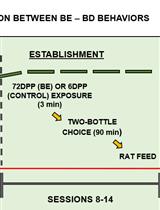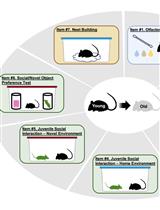- EN - English
- CN - 中文
Rat Model of Empathy for Pain
疼痛共情的大鼠模型
(*contributed equally to this work) 发布: 2019年06月20日第9卷第12期 DOI: 10.21769/BioProtoc.3266 浏览次数: 6031
评审: Arnau Busquets-GarciaEdgar Soria-GomezLA Stetzik

相关实验方案

从食物到酒精的狂饮:雄性Wistar大鼠嗜酒行为之间的顺序相互作用
Sergio Cuesta-Martínez [...] Cruz Miguel Cendán
2023年08月05日 837 阅读
Abstract
Empathy for pain is referred to as an evolutionary behavior of social animals and humans associated with the ability to feel, recognize, understand and share the other's distressing (pain, social rejection and catastrophe) states. Impairment of empathy can definitely lead to deficits in social communication and sociability (attachment, bond, reciprocity, altruism and morality) that may be fundamental to some psychiatric disorders such as autism spectrum disorder (ASD), psychopathy, misconduct, antisocial personality disorder and schizophrenia. So far, the underlying mechanisms of empathy are poorly known due to lack of animal models and scarce understanding of its biological basis. Recently, we have successfully identified and validated the behavioral identities of empathy for pain in rats that can be widely used as a rodent model for studying the underlying biological mechanisms of empathy. Priming dyadic social interaction between a naive cagemate observer (CO) and a cagemate demonstrator (CD), rather than a non-cagemate, in pain for 30 min in a testing box can repeatedly and constantly result in empathic responses of the CO toward the familiar CD's distressing condition, displaying as allo-licking at the injury site, allo-grooming at the body and social transfer of pain. The familiarity-based, distress-specific social consolation and subsequent social transfer of pain can be qualitatively and quantitatively rated as experimental biomarkers for empathy for pain. The rodent model of empathy for pain is state-of-the-art and has more advantages than the existing ones used for social neuroscience since it can reflect sensory, emotional and cognitive processes of the brain in running the prosocial and altruistic behaviors in animals who could not report verbally. Here we would like to provide and share the protocol of the model for wide use.
Keywords: Empathy (共情)Background
Empathy for pain is referred to as an evolutionary behavior of social animals and humans associated with the ability to feel, recognize, understand and share the other's distressing (pain, social rejection and catastrophe) states (Chen, 2018). Impairment of empathy can definitely lead to deficits in social communication and sociability (attachment, bond, prosocial reciprocity, altruism and morality) that may be fundamental to some psychiatric disorders such as autism spectrum disorder (ASD), psychopathy, misconduct, antisocial personality disorder and schizophrenia (de Waal and Preston, 2017; Chen, 2018). In humans, empathy for pain has been demonstrated to be processed by a common core neural network mainly involving the anterior cingulate cortex (ACC) and anterior insular cortex which are also associated with direct feeling of emotional pain (Rainville et al., 1997; Singer et al., 2004; Lamm et al., 2011). Psychologically, empathy for pain can be expressed as changes in emotional state (feeling of pain, anxiety, etc.) and cognitive functions (attentional bias) of a subject who is witnessing distressing condition of others, especially his/her familiars (family members, kin, friends, colleagues, etc.), and this can subsequently motivate empathic concern, consolation and help in behavior (Darwin, 1871; Burkett et al., 2016; de Waal and Preston, 2017). Moreover, vicariously felt pain or social transfer of pain from a distressing object to a witnessing subject is frequently evidenced as empathic pain feeling (lowed pain threshold or enhanced pain sensitivity) in humans (Goubert et al., 2005; Williams and Rhudy, 2007; Loggia et al., 2008; Villemure and Bushnell, 2009; Godinho et al., 2012).
In the past century, the understanding of empathy has been greatly limited to the higher species such as human and non-human primates due to academic rejection of experimental studies in lower animals such as rodents (Panksepp, 1998; Panksepp and Lahvis, 2011; Panksepp and Panksepp, 2013; Chen, 2018). However, more recently, empathy for pain has been reported to consistently exist in both mice (Langford et al., 2006; Martin et al., 2015) and rats (Li et al., 2014 and 2018; Lü et al., 2017 and 2018) following social interactions between dyadic familiar (cagemate) conspecifics but not stranger (non-cagemate) ones for which both or one animal is in pain (for reviews see Martin et al., 2014; Mogil, 2015; Chen, 2018). It is of special interest to note that the establishment of familiarity among conspecifics by co-housing them for more than two weeks is essential to induction of empathic responses to other’s pain in both mice and rats (Martin et al., 2014; Mogil, 2015; Chen, 2018). According to the Russian-doll model of the evolution of empathy proposed by de Waal and his colleague, empathy is hierarchical and evolved from the very core (motor mimicry and emotional contagion) to more outer layer (empathic concern and consolation) and to the most outer layer (perspective-taking and targeted-help) (de Waal and Preston, 2017). It is interesting to find that, in our experimental studies, rats have an ability to feel, recognize and share the distressing feeling of another familiar conspecific in pain, resulting in empathic consolation and social pain contagion (Li et al., 2014 and 2018; Lü et al., 2017 and 2018), highly supporting the Russian-doll model. In comparing to the existing mouse model published previously, the rat model of empathy for pain has several advantages as follows: (1) The CO rat is under naive condition prior to and during priming dyadic social interaction, this can completely exclude the distressing effects of direct physical pain stimulation on itself and make neurobiological, endocrine and other biological assays possible in further tests. However, it is well known that Langford and his colleagues used ‘observer-demonstrator both in pain’ model in their mouse study that could not distinguish between the effects of physical pain and vicariously felt pain (empathy for pain) (Langford et al., 2006). (2) Our rat model of empathy for pain has been validated to have both empathic consolation (allo-grooming and allo-licking) and social pain contagion (empathic pain hypersensitivity) that is consistent with what has been observed in human, non-human primates and some other special species such as socially monogamous, biparental prairie vole (Burkett et al., 2016; de Waal and Preston, 2017). (3) Our rat model of empathy for pain has been approved to be mediated by top-down facilitation from the medial prefrontal cortex (mPFC) and the locus coeruleus (LC)-norepinephrine (NE) system (Li et al., 2014; Lü et al., 2017) that are known to be important brain structures involved in empathy for pain in humans (Singer et al., 2004; Terbeck et al., 2016). (4) Our unpublished data showed that mice have the same ability as rats in empathy for pain, suggesting no species difference between the two laboratory rodents tested by our experimental setting and designs. (5) Our rodent model of empathy for pain provides a novel bio-psychosocial-brain-behavioral paradigm that can be used in combination with other advanced techniques in neuroscience such as optogenetic, chemogenetic, in-vivo multi-electrode array recordings and other neuroimaging approaches in consciously socially interacting animals. Here we mainly describe a well-established approach used in rat model of empathy for pain in a step-by-step manner.
Materials and Reagents
- Materials
- Microsyringe (50 μl) (Gaoge, China)
- Microsyringe (50 μl) (Gaoge, China)
- Animals
- Sprague-Dawley albino rats (6 weeks old, 150-180 g), purchased from the Laboratory Animal Center of the Fourth Military Medical University (FMMU)
- Co-housing 4-6 rats of the same sex per cage in a specific-pathogen free (SPF) animal facility with a humidity of 40-60% and a room temperature (RT) of 22-26 °C for two to three weeks after arrival at the Tangdu hospital of the FMMU.
- Keep rats under a 12:12 h light/dark cycle (light off during 20:00-08:00).
- Make water and food available at libitum.
- Sprague-Dawley albino rats (6 weeks old, 150-180 g), purchased from the Laboratory Animal Center of the Fourth Military Medical University (FMMU)
- Reagents
- Lyophilized whole venom of Apis millifera or bee venom [BV, item number: V3375, Merck Life Science (Shanghai) Co., Ltd, China].
- Formalin solution (Sinopharm Chemical Reagent Co., Ltd, China)
- 0.4% BV solution (see Recipes)
- 2.5% formalin solution (see Recipes)
Equipment
- Video camera recorder (VCR, Sony, FDR-AX40, Japan)
- Precise Tactile Sensory Evaluator: von Frey monofilaments (Ugobasile, catalog number: 37450-275, Italy)
- Mechanical pain sensitivity test device
The mechanical pain sensitivity test setting (customized apparatus) includes a supporting platform and a nontransparent plastic testing box for limiting the range of movement of animals. The supporting platform (160 x 30 x 40 cm) is equipped with metal mesh. The pore size of the mesh (0.5 cm x 0.5 cm) is preferably such that the rat can move freely on the surface without getting caught. - Plastic observing cage
Another plastic observing cage covered with sterilized wooden padding at the bottom surface serves as an arena for dyadic social interaction and communication (40 x 30 x 15 cm, customized apparatus).
Software
- Statistical test (SPSS 25.0)
- Graph and artwork (GraphPad Software Inc. California, USA, GraphPad Prism 7.0)
Procedure
文章信息
版权信息
© 2019 The Authors; exclusive licensee Bio-protocol LLC.
如何引用
Yu, Y., Li, C., Du, R. and Chen, J. (2019). Rat Model of Empathy for Pain. Bio-protocol 9(12): e3266. DOI: 10.21769/BioProtoc.3266.
分类
神经科学 > 行为神经科学 > 实验动物模型
您对这篇实验方法有问题吗?
在此处发布您的问题,我们将邀请本文作者来回答。同时,我们会将您的问题发布到Bio-protocol Exchange,以便寻求社区成员的帮助。
提问指南
+ 问题描述
写下详细的问题描述,包括所有有助于他人回答您问题的信息(例如实验过程、条件和相关图像等)。
Share
Bluesky
X
Copy link










